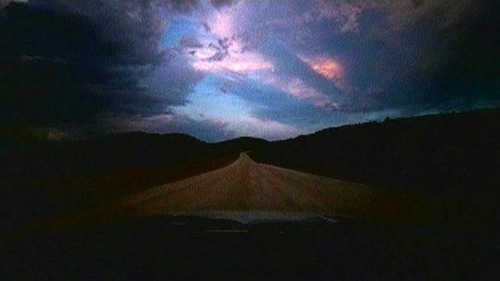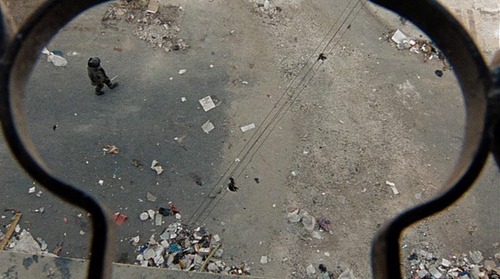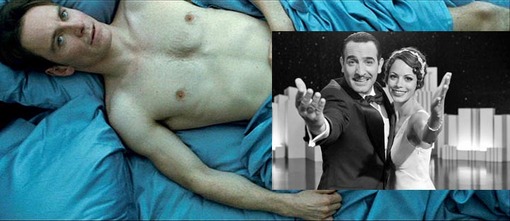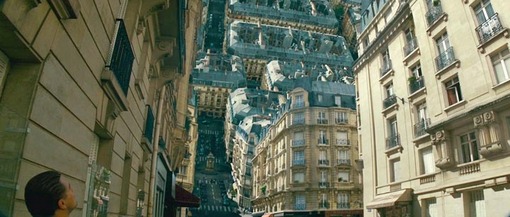View image A stunning shot from “The Bourne Supremacy” that does preserve spacial integrity: It begins from the inside of the car, looking out the rear window.
View image A whip-pan to driver Bourne puts us in the passenger seat.
“[‘The Bourne Ultimatum’] has been described as bare-bones but it’s actually quite flashy. All the crashing zooms (accompanied by whams on the soundtrack), jittery shots, drifting framings, uncompleted pans, freeze-frame flashbacks, and other extroverted devices call attention to themselves.”
— David Bordwell
View image A beautiful example of indirection: Bourne is still looking in the rear-view mirror at the cop cars that are chasing him. His attention is not focused on the road ahead of him — or the side-street visible to us out his driver’s side window, as he passes through the intersection.
View image The police car is already trying to brake/swerve to avoid collision, but Bourne’s attention is still behind him.
It is possible that there are four non-moving-camera shots in “The Bourne Ultimatum.” That’s how many I thought I saw, anyway. I wasn’t taking notes, but I believe the only shots that weren’t shaking, dollying, zooming, tilting, panning, refocusing or some combination of all those things are: two consecutive shots as Bourne breaks into Daniels’ CIA office in Madrid; a high-angle flashback image of Bourne sitting in a chair in The Room; a shot from behind the desk of a committee in a hearing room. There could be a few more tripod (or non-telephoto, carefully hand-held) shots — a brief establishing shot of Turin (which may have been taken from a hovering helicopter), a really quick interior or two during a chase through some buildings in Tangiers, a couple dark underwater night shots where there are no fixed visual bearings — but that’s out of approximately 3,200 shots (by David Bordwell’s count) in a 105-minute movie. They really stood out. Bordwell determined the average shot length in the film to be about 2 seconds, and the stationary shots I couldn’t help but notice were probably in the one- to three-second range.
View image Bourne turns his head away to look back. He doesn’t see what’s coming, though we do, and that makes it feel all the more suspenseful and shocking — all in less than a second.
View image Crash. This is a hand-held shot (lasting only 2-3 seconds), but it feels logical and natural, like the head-motion of a passenger looking back and then to the side at the driver, which magnifies the impact.
I sat in the third row, as usual, in a fairly big auditorium at Seattle’s Oak Tree Cinemas (maybe 500-600 seats?), and I found Paul Greengrass’s style in this film to be distracting almost to the point of self-parody. I was a big fan of “Bloody Sunday” and “Bourne Supremacy,” but this one (and “United 93”) didn’t impress me as much. “Supremacy,” I thought, was stronger because it was better at establishing your (and the characters’) bearings. “Ultimatum” made my eyes hurt a little, but I didn’t get nauseous — as some reportedly have. I hung around and listened to ticket-buyers exiting the theater, and while I overheard a couple of say the movie had made them extremely “nervous” and “edgy” (and that’s by no means a negative reaction to a thriller), I didn’t hear anybody complain that they felt like throwing up.
My problem with the film was that the “look-at-me!” technique kept whiplashing me right out of the picture. This kind of camerawork, with its rapid and disorienting glimpses of abstract motion, is often effective during a chase or an action sequence, but Greenglass chose to shoot every moment in the picture this way, including simple dialog scenes around a desk or a table in a cafe. (The repeated use of the back-of-the-head eclipsing half a person’s face in close-up, for no particular reason, was so silly it made me laugh inappropriately.)
People’s heads, of course, are not usually perfectly steady, but we’re not conscious of every single move our eyeballs make, either. If we were, well, we’d probably puke a lot more often. The exceedingly self-conscious camerawork in “Bourne Ultimatum” didn’t feel organic or (as Peter Debruge calls it, “immersive”) to me; it actually felt studied, like a formal strategy that was simply being pursued to the point where it became counter-effective. Maybe that’s in part because of what I’d already read about the movie — and also because of my customary vantage in the third row, I don’t know.
December 14, 2012





